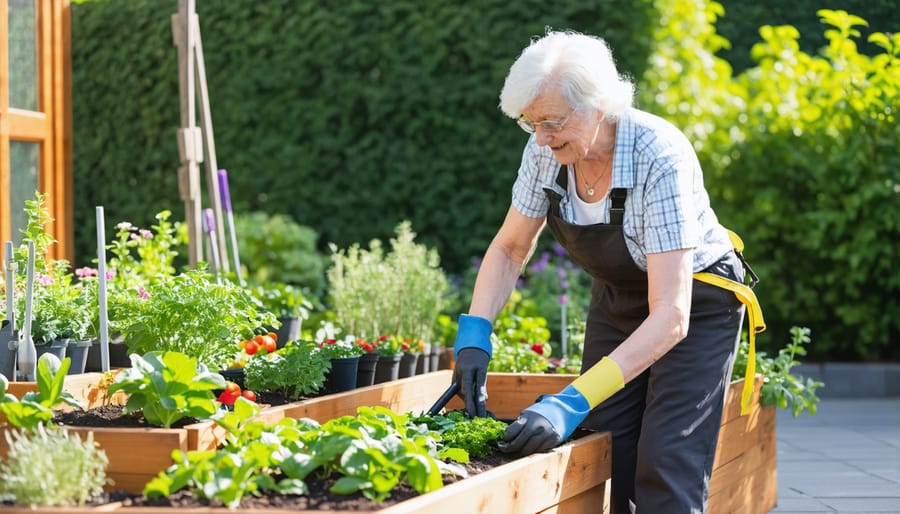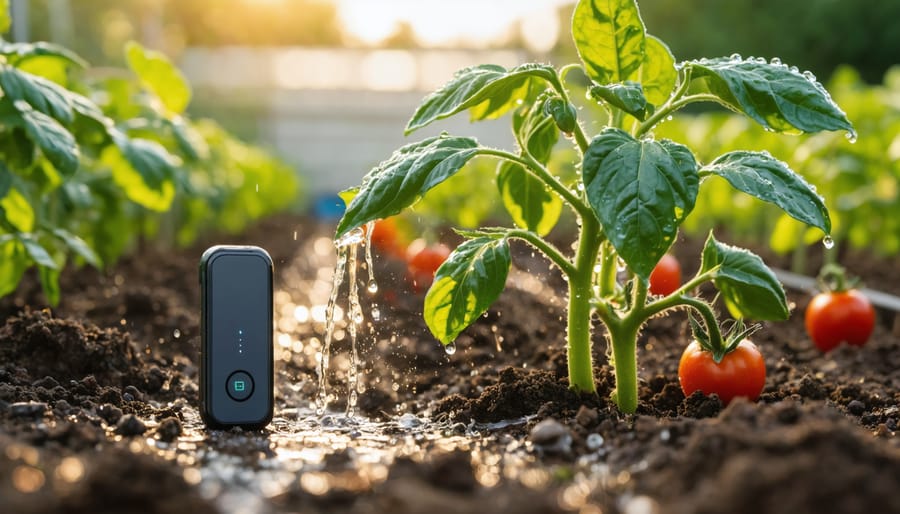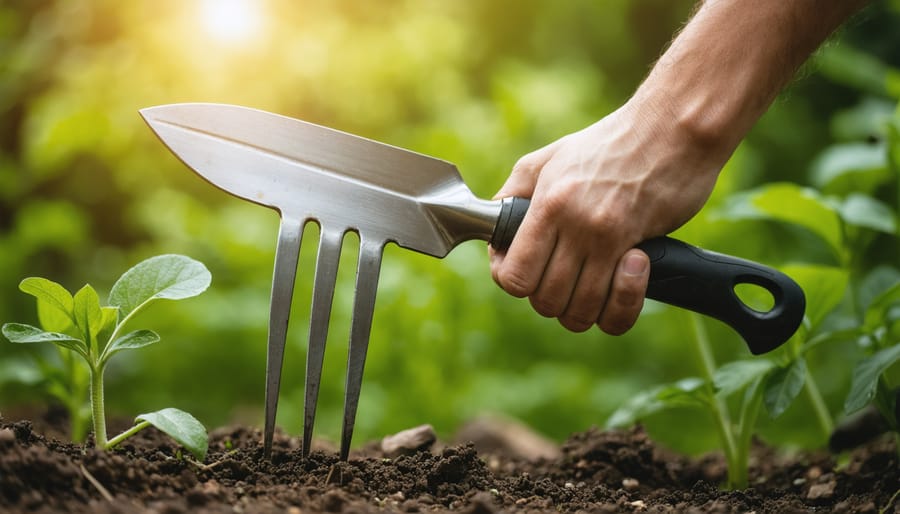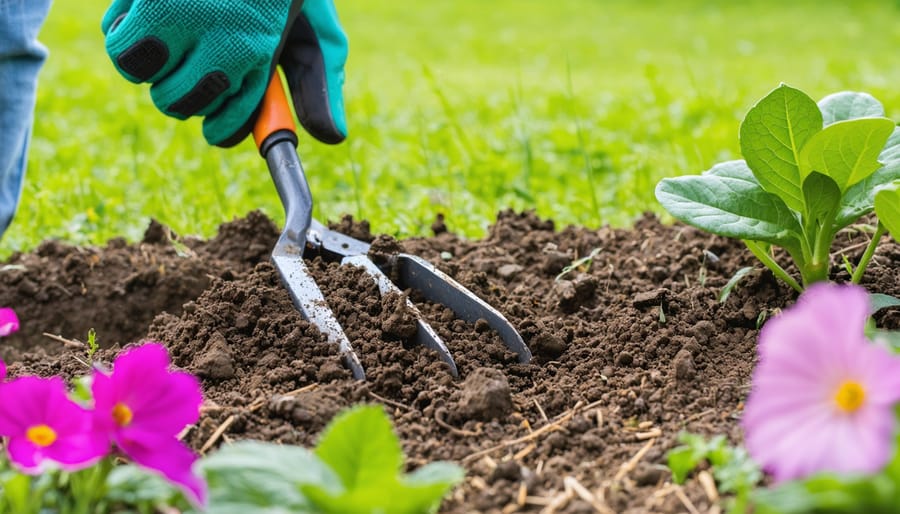Dig your hands into cool, rich soil and feel your stress melt away – gardening isn’t just a hobby, it’s scientifically proven therapy for both mind and body. As you nurture tiny seeds into flourishing plants, your brain releases serotonin and dopamine, the same “feel-good” chemicals triggered by meditation and exercise. Studies from the Journal of Health Psychology show that just 30 minutes of gardening significantly reduces cortisol levels – our primary stress hormone – more effectively than indoor relaxation activities.
Beyond the science, gardening connects us to nature’s rhythm in an increasingly digital world. Whether you’re tending to a sprawling backyard garden or nurturing a few potted herbs on your windowsill, the simple act of caring for living things provides a sense of purpose and accomplishment that’s becoming rare in our fast-paced lives. The gentle rustling of leaves, the earthy scent of soil, and the satisfaction of harvesting your own produce create a multi-sensory experience that grounds us in the present moment.
This article explores how modern gardening practices can be intentionally used as a therapeutic tool, combining ancient wisdom with contemporary research to help you cultivate not just a garden, but also peace of mind.
The Science Behind Gardening’s Therapeutic Effects
Stress Reduction and Mental Health Benefits
Scientific research continues to validate what many gardeners have long known intuitively – getting your hands dirty in the garden can significantly reduce stress levels. A groundbreaking study published in the Journal of Health Psychology found that gardening can lower cortisol levels (our primary stress hormone) by up to 22% after just 30 minutes of activity.
Beyond stress reduction, gardening has been shown to improve mood and decrease symptoms of anxiety and depression. When you create a zen garden space, you’re not just designing a beautiful outdoor area – you’re crafting a natural sanctuary for mental wellness.
The mindful nature of gardening activities, from planting seeds to pruning plants, helps practitioners stay present and focused, similar to meditation. This natural mindfulness, combined with light physical activity and exposure to vitamin D from sunlight, creates a powerful cocktail of mood-boosting benefits.
Researchers have also noted that the beneficial bacteria in soil can trigger the release of serotonin in our brains, contributing to feelings of wellbeing and contentment. This might explain why many gardeners report feeling happier and more relaxed after spending time tending to their plants.

Physical Health Improvements
Gardening offers a complete full-body workout that strengthens muscles, improves flexibility, and enhances overall physical health. When you dig, plant, and weed, you engage multiple muscle groups, particularly in your arms, shoulders, back, and legs. These activities provide low-impact exercise that’s gentler on your joints compared to traditional workouts.
Regular gardening can help burn anywhere from 200-400 calories per hour, making it an effective way to maintain a healthy weight. The varied movements involved in gardening – reaching, bending, lifting, and walking – improve balance and coordination, which becomes increasingly important as we age.
Time spent outdoors in the garden also increases vitamin D absorption through natural sunlight exposure, supporting bone health and immune system function. The repetitive nature of gardening tasks helps build strength and endurance gradually, while the fresh air and physical activity contribute to better sleep patterns and increased energy levels.
Best of all, gardening doesn’t feel like exercise – it’s an enjoyable activity that naturally encourages movement and physical activity, making it easier to maintain as a regular part of a healthy lifestyle.
Smart Technology Making Therapeutic Gardening Easier

Plant Monitoring Systems
In today’s digital age, the therapeutic benefits of gardening can be enhanced through smart gardening technology that helps reduce the anxiety of plant care. Modern plant monitoring systems act like gentle gardening companions, providing peace of mind and allowing you to focus on the joy of watching your plants grow.
These user-friendly devices measure essential factors like soil moisture, light levels, and temperature, sending notifications right to your smartphone when your plants need attention. Instead of worrying about whether you’re watering too much or too little, these smart sensors give you clear guidance, helping you develop a more intuitive understanding of your plants’ needs.
Many gardeners find that using these monitoring systems actually deepens their connection with their gardens. Rather than creating distance through technology, these tools provide valuable insights that help you better understand your plants’ natural rhythms. They’re particularly helpful for beginners who might feel overwhelmed by plant care responsibilities, offering gentle reminders and educational tips that build confidence over time.
Popular apps also create supportive communities where you can share your gardening journey, ask questions, and celebrate successes with fellow plant enthusiasts. This social aspect, combined with the reassurance of knowing your plants are thriving, adds another layer of therapeutic benefit to your gardening experience.
Automated Watering Solutions
For many gardeners, the worry of under or overwatering plants can create anxiety that counteracts the therapeutic benefits of gardening. Thankfully, modern automated watering solutions have evolved to take this stress away, allowing you to focus on the more enjoyable aspects of tending to your garden.
Smart irrigation systems now come with soil moisture sensors that monitor your plants’ exact needs, delivering water only when necessary. These systems can be controlled through smartphone apps, letting you check on your garden’s hydration status even when you’re away. Some advanced models even factor in weather forecasts and adjust watering schedules accordingly.
For indoor gardeners, self-watering planters have become increasingly sophisticated. These planters feature water reservoirs that use capillary action to provide consistent moisture to your plants, eliminating the guesswork of when to water. Timer-based drip systems are another excellent option, particularly for container gardens or raised beds, providing measured amounts of water at scheduled intervals.
What makes these solutions particularly therapeutic is the peace of mind they bring. No more rushing home from vacation to water wilting plants or fretting about whether you’ve given them too much or too little water. This technology allows you to maintain a deeper connection with your garden by focusing on nurturing and growth rather than worrying about basic maintenance.
Garden Planning Apps
For those who find garden planning overwhelming, modern technology offers a helping hand through various gardening apps. These digital tools can transform the sometimes daunting task of garden design into an enjoyable and therapeutic activity.
Popular apps like Garden Plan Pro and Gardenia help you visualize your garden layout before lifting a single shovel. They offer drag-and-drop features that let you experiment with different plant combinations and arrangements, reducing anxiety about making permanent decisions in your actual garden.
Many of these apps include built-in calendars that remind you when to plant, water, and harvest, taking the stress out of timing. Apps like PlantSnap and PictureThis can identify plants through your smartphone camera, making it easier to learn about the plants in your garden and surrounding environment.
For mindful gardening, apps like Planta not only help you care for your plants but also encourage regular interaction with your garden through gentle reminders and plant care tips. Some apps even include community features where you can connect with fellow gardeners, share experiences, and get advice.
Remember, while these apps are helpful tools, they shouldn’t replace the therapeutic experience of getting your hands dirty. Use them as supportive resources to enhance your gardening journey rather than letting them dictate every aspect of your garden care routine.
Adaptive Gardening Technologies

Ergonomic Tools for Physical Limitations
Modern gardening has evolved to accommodate everyone’s needs, making it more accessible than ever. Adaptive gardening tools have revolutionized the way people with physical limitations can enjoy this therapeutic activity.
Long-handled tools with ergonomic grips reduce strain on your back and joints, allowing you to work comfortably from a standing position. For those who prefer seated gardening, specialized kneelers that convert into seats provide stable support while tending to plants. Lightweight tools with cushioned handles minimize hand fatigue and are perfect for gardeners with arthritis or reduced grip strength.
Rolling garden seats and scooters make it easy to move around your garden without straining your legs or back. These mobility aids often come with built-in storage for tools and small plants. Raised garden beds and vertical gardening systems bring plants to a comfortable working height, eliminating the need to bend down repeatedly.
Tool adaptations like arm support cuffs and easy-grip handles can be attached to existing garden tools, making them more manageable for those with limited mobility or strength. Additionally, ergonomic watering wands and self-coiling hoses reduce the physical effort needed for regular plant maintenance.
With these thoughtful tool designs, gardening remains an accessible and enjoyable activity for everyone, regardless of physical limitations.
Vertical and Container Gardening Solutions
Don’t let limited space hold you back from experiencing the therapeutic benefits of gardening. Vertical and container gardening solutions have revolutionized the way we can grow plants, making it possible to create green sanctuaries in even the smallest spaces.
Vertical gardens can transform blank walls into living tapestries of greenery. Try installing a pocket garden system or repurpose a shoe organizer to create a cascading display of herbs and small plants. These systems not only maximize space but also bring nature to eye level, making plant care more accessible and enjoyable.
Container gardening offers incredible flexibility. From classic terra cotta pots to innovative self-watering planters, you can cultivate everything from compact tomatoes to aromatic lavender on balconies, patios, or windowsills. Stack containers using tiered stands or create a mobile garden with wheeled planters, allowing you to follow the sun or bring plants indoors during harsh weather.
For indoor spaces, consider hydroponic tower gardens that combine modern technology with traditional growing methods. These systems can provide year-round access to fresh herbs and vegetables while creating a soothing atmosphere with their gentle water flow.
Remember to choose plants that match your available light conditions and space constraints. Even a small collection of potted plants can create a meaningful connection with nature and provide the therapeutic benefits of gardening.
Creating Your Tech-Enhanced Therapeutic Garden
Getting Started with Basic Tech Tools
In today’s digital age, incorporating technology into your therapeutic gardening practice can enhance both your gardening success and overall wellness experience. While traditional gardening tools remain essential, several user-friendly tech tools can help you create a more mindful and efficient garden space.
Start with a basic weather app on your smartphone to track local conditions and plan your gardening sessions. Many free apps offer detailed forecasts, rainfall predictions, and frost warnings, helping you make informed decisions about plant care and outdoor time.
A digital moisture meter is another invaluable tool for beginners. These affordable devices take the guesswork out of watering by measuring soil moisture levels, reducing plant stress and helping you develop a better understanding of your garden’s needs.
For those interested in tracking their gardening journey, garden planning apps can help document progress, set reminders for plant care, and identify plants through photo recognition. These digital tools can also provide a therapeutic outlet by allowing you to journal your experiences and capture beautiful moments in your garden.
Consider exploring automated garden systems as you become more comfortable with technology. Simple timer-controlled watering systems can reduce stress and ensure consistent plant care, while smart sensors can monitor environmental conditions to optimize plant growth.
Remember, technology should enhance, not complicate, your gardening experience. Start with one or two tools that interest you most and gradually expand your tech toolkit as your confidence grows.
Building a Sustainable Practice
Building a sustainable therapeutic gardening practice is easier than ever with today’s technology. Start by downloading a garden planning app to track your plantings and schedule maintenance tasks. These digital tools can send reminders for watering, fertilizing, and pruning, helping you develop consistent habits without feeling overwhelmed.
Consider using smart irrigation systems that connect to your smartphone, allowing you to monitor soil moisture and automate watering schedules. This technology not only saves time but also reduces stress about plant care while you’re away. Many gardeners find that plant identification apps help them learn about new species and make informed choices about what to grow next.
Create a digital garden journal using notes apps or specialized gardening software to document your progress, successes, and learning experiences. Include photos of your garden’s development – this visual record can be incredibly rewarding and motivating during the off-season.
To maintain motivation, join online gardening communities where you can share experiences and seek advice. Many platforms offer virtual garden tours and live workshops, connecting you with fellow enthusiasts worldwide. Consider setting up a simple weather station to better understand your microclimate and optimize growing conditions.
Remember to balance technology use with unplugged gardening time. The therapeutic benefits often come from direct contact with soil and plants, so use tech as a support tool rather than the main focus of your practice.
The fusion of technology with therapeutic gardening opens up exciting possibilities for enhancing our mental well-being and connection with nature. From garden planning apps to smart sensors that help us nurture our plants more effectively, these tools make the journey more accessible and enjoyable for everyone. Whether you’re seeking stress relief, a mindful hobby, or a way to improve your overall mental health, therapeutic gardening enriched by technology offers a perfect blend of ancient wisdom and modern convenience. Start small, perhaps with a few potted herbs on your windowsill or a simple garden bed, and let technology guide you along the way. Remember, every plant you nurture not only grows your garden but also cultivates inner peace and well-being. The time to start your therapeutic gardening journey is now – your mind and spirit will thank you for it.




